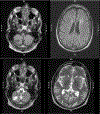The neurologist who could not stop rhyming and rapping
- PMID: 35067191
- PMCID: PMC9064902
- DOI: 10.1080/13554794.2022.2027455
The neurologist who could not stop rhyming and rapping
Abstract
.A neurologist, at age 55, developed an irrepressible urge to rhyme after a series of strokes and seizures. His strokes included right posterior cerebellar and right thalamic infarctions, and his subsequent focal-onset seizures emanated from the left frontotemporal region. On recovery, he described the emergence of an irresistible urge to rhyme, even in thought and daily speech. His pronounced focus on rhyming led him to actively participate in freestyle rap and improvisation. This patient's rhyming and rapping may have been initially facilitated by epileptiform activation of word sound associations but perpetuated as compensation for impaired cerebellar effects on timed anticipation.
Keywords: Rhyme; brain; epilepsy; rap; rhythm; vascular cognitive impairment.
Conflict of interest statement
Declaration of Interest:
Figures


Similar articles
-
Auditory rhyme processing in expert freestyle rap lyricists and novices: An ERP study.Neuropsychologia. 2019 Jun;129:223-235. doi: 10.1016/j.neuropsychologia.2019.03.022. Epub 2019 Apr 3. Neuropsychologia. 2019. PMID: 30951740
-
Neural Indices Mediating Rhyme Discrimination Differ for Some Young Children Who Stutter Regardless of Eventual Recovery or Persistence.J Speech Lang Hear Res. 2020 Apr 27;63(4):1053-1070. doi: 10.1044/2020_JSLHR-19-00260. Epub 2020 Apr 17. J Speech Lang Hear Res. 2020. PMID: 32302258 Free PMC article.
-
The perception and production of rhyme in normal and developmentally apraxic children.J Commun Disord. 1993 Sep;26(3):129-60. doi: 10.1016/0021-9924(93)90005-u. J Commun Disord. 1993. PMID: 8227501
-
Cognitive and linguistic dysfunction after thalamic stroke and recovery process: possible mechanism.AIMS Neurosci. 2021 Dec 20;9(1):1-11. doi: 10.3934/Neuroscience.2022001. eCollection 2022. AIMS Neurosci. 2021. PMID: 35434274 Free PMC article. Review.
-
Evocation and inhibition of seizures. Behavioral treatment.Adv Neurol. 1991;55:163-83. Adv Neurol. 1991. PMID: 2003405 Review.
References
-
- Andreasen NC (1986). Scale for the assessment of thought, language, and communication (TLC). Schizophr Bull, 12(3), 473–482. http://www.ncbi.nlm.nih.gov/pubmed/3764363 - PubMed
-
- Argyropoulos GPD, van Dun K, Adamaszek M, Leggio M, Manto M, Masciullo M, Molinari M, Stoodley CJ, Van Overwalle F, Ivry RB, & Schmahmann JD (2020). The Cerebellar Cognitive Affective/Schmahmann Syndrome: a Task Force Paper. Cerebellum, 19(1), 102–125. 10.1007/s12311-019-01068-8 - DOI - PMC - PubMed
-
- Assal G, & Buttet J (1983). [Agraphia and preservation of music writing in a bilingual piano teacher]. Rev Neurol (Paris), 139(10), 569–574. https://www.ncbi.nlm.nih.gov/pubmed/6648195 - PubMed
Publication types
MeSH terms
Grants and funding
LinkOut - more resources
Full Text Sources
Medical
